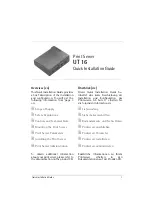
SuperServer 4029GP-TVRT User's Manual
90
Serial Port 2 Configuration
Serial Port
Select Enabled to enable the onboard serial port specified by the user. The options are
Enabled
and Disabled.
Device Settings
This feature displays the base I/O port address and the Interrupt Request address of a serial
port specified by the user.
Note:
This item is hidden when Serial Port 1 is set to Disabled.
Change Settings
This feature specifies the base I/O port address and the Interrupt Request address of Serial
Port 2. Select Auto for the BIOS to automatically assign the base I/O and IRQ address to a
serial port specified. The options for Serial Port 2 are
Auto
, (IO=2F8h; IRQ=3), (IO=3F8h;
IRQ=3, 4, 5, 6, 7, 9, 10, 11, 12), (IO=2F8h; IRQ=3, 4, 5, 6, 7, 9, 10, 11, 12); (IO=3E8h; IRQ=3,
4, 5, 6, 7, 9, 10, 11, 12), and (IO=2E8h; IRQ=3, 4, 5, 6, 7, 9, 10, 11, 12).
Serial Port 2 Attribute
Select SOL to use COM Port 2 as a Serial_Over_LAN (SOL) port for console redirection.
The options are COM and
SOL
.
Serial Port Console Redirection
COM 1 Console Redirection
Select Enabled to enable COM Port 1 for Console Redirection, which will allow a client
machine to be connected to a host machine at a remote site for networking. The options are
Enabled and
Disabled
.
*If the item above set to Enabled, the following items will become available for
configuration:
Console Redirection Settings (when COM1 Console Redirection is
Enabled)
Terminal Type
Use this feature to select the target terminal emulation type for Console Redirection.
Select VT100 to use the ASCII Character set. Select VT100+ to add color and function key
support. Select ANSI to use the Extended ASCII Character Set. Select VT-UTF8 to use
UTF8 encoding to map Unicode characters into one or more bytes. The options are
ANSI,
VT100,
VT100+
, and VT-UTF8.
















































